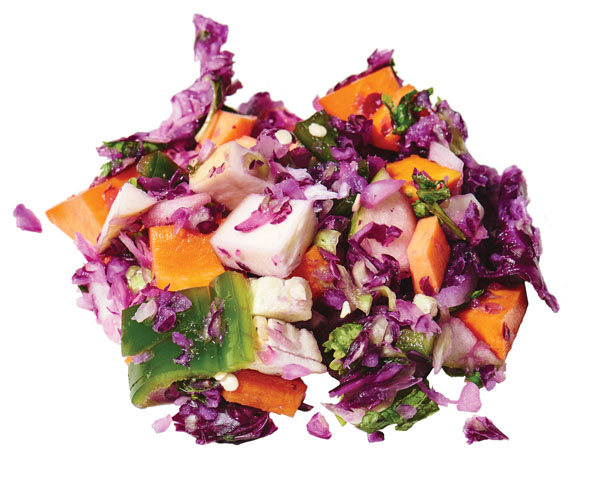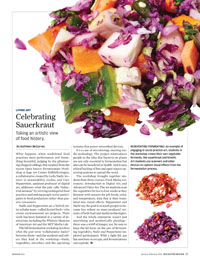In Review
 REINVENTING FERMENTING: An example of engaging in social practice art, students in the workshop create their own vegetable
ferments, like sauerkraut and kimchi. Art students use scanners and other devices to capture visual effects from the fermentation
process. (Photo: Brandon Vick)
REINVENTING FERMENTING: An example of engaging in social practice art, students in the workshop create their own vegetable
ferments, like sauerkraut and kimchi. Art students use scanners and other devices to capture visual effects from the fermentation
process. (Photo: Brandon Vick)What happens when traditional food practices meet performance art? Something beautiful, judging by the glimmering chopped cabbage that resulted from the recent Open Source Fermentation Workshop at Sage Art Center. EdibleEcologies, a collaborative created by Leila Nadir, lecturer in sustainability studies, and Cary Peppermint, assistant professor of digital art, addresses what the pair calls “industrial amnesia” by reviving endangered food practices and making people active participants in food production rather than passive consumers.
Nadir and Peppermint are a hybrid artist-scholar team—called EcoArtTech—who create environmental art projects. Their work has been featured at a variety of institutions, including the Whitney Museum of American Art and the MIT Media Lab.
The fall fermentation workshop involves what the pair term “collaborative hacks” between them—and the students and others they lead in the workshop—fruits, vegetables, microbes, and the operating systems that power networked devices.
It’s a case of microbiology meeting media technology. The project reintroduces people to the idea that bacteria on plants are not only essential to fermentation but also can be beneficial to health. And it uses ethical hacking of free and open-source operating systems to spread the word.
The workshop brought together students from three courses: Food, Media, Literature; Introduction to Digital Art; and Advanced Video Art. The art students scan the vegetables for two to four weeks as they ferment with sensors for pH levels, color, and temperature, data that is then translated into visual effects. Peppermint and Nadir say the goal is to teach people to become less reliant on mass-produced versions of both food and media technologies.
And the whole enterprise wasn’t just nourishing and aesthetically pleasing—there was a whiff of danger, too. Be sure to keep the lid loose on the jars of fermenting vegetables, Nadir and Peppermint implored participants. With a tight lid, gas has nowhere to escape, and fermentations can explode.

